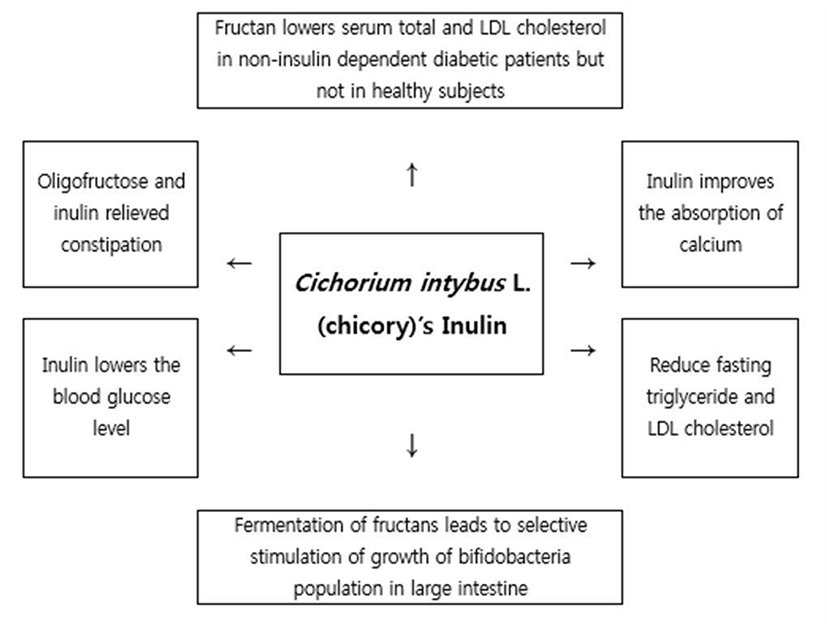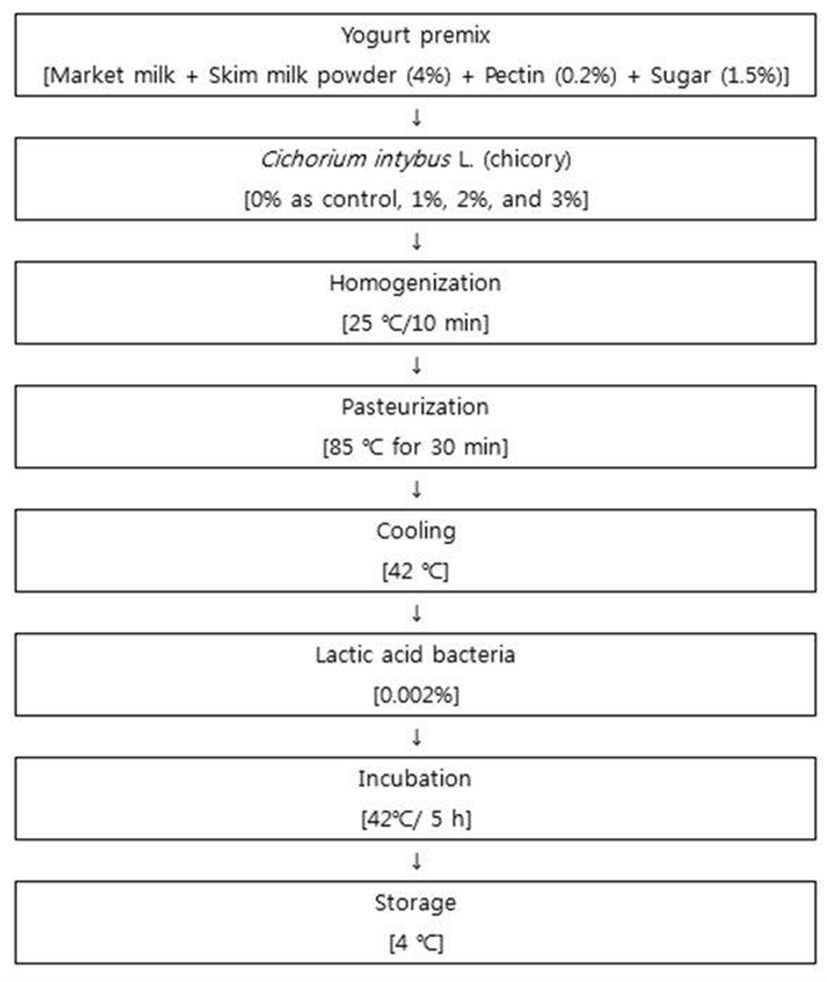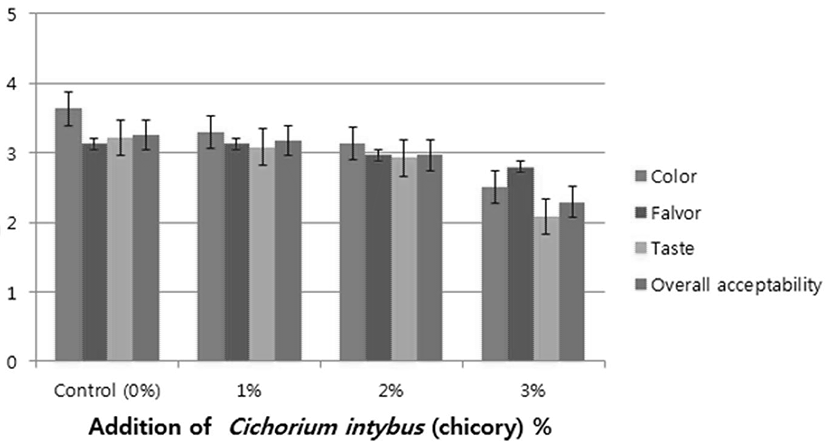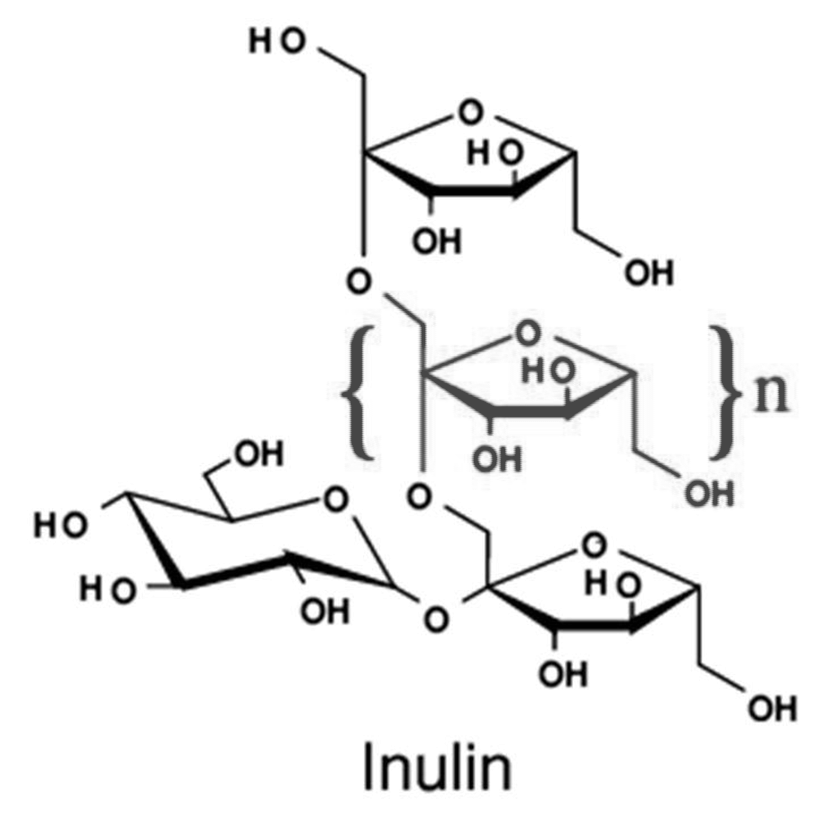Introduction
Cichorium intybus L. (chicory), a perennial herb of the Asteraceae family, with blue, lavender, or occasionally white flowers, is also known as blue sailors, endive, succory, and coffeeweed, Kashen’na or Kasini (Uigur), is native to the Mediterranean region, mid Asia and northern Africa. In general, Cichorium intybus L. (chicory) is a major crop in northwestern Europe, and its roots are a rich source of the dietary fiber inulin. For example, Cichorium intybus L. (chicory) roots are used in the preparation of a bitter drink as a substitute for coffee in France and Japan. People of all ages can drink the extract from chicory root, because it has non-caffeine ingredients. Chicory inulin also has the potential to replace dietary fat, resulting in decreased calorie intake. When inulin is mixed with water or any other aqueous liquid, it forms a colloidal suspension providing a white, creamy emulsion. Inullin, one of the fructooligosaccharides, is a linear fructose polymer with beta glycosidic linkages. Fructooligosaccharides, short chain fructans built of 2-10 residues via β-(2→1) glycosidicbond and with terminal unit of a glucose molecule linked with a fructose molecule by α-(2→1) glycosidic bond, are structurally similar to inulin (Fig. 1).
Inulin is nondigestible, fully soluble, and widely found in nature in a variety of plants and in some bacteria and fungi. As already known, Inulin has various pharmacological effects (Fig. 2). The addition of inulin to a moderately high-carbohydrate low-fat diet has a beneficial effect on plasma lipids by decreasing hepatic lipogenesis and plasma triacylglycerol concentrations.

Hence, producers in the dairy industry would like to introduce milk and yogurt products with beneficial health properties. Of interest are performance- and immune- boosting products that could contain plant material from adaptogenic plant species. For example, species such as Russian root (Eleutherococcus senticosus), ginseng root (Panax ginseng), Arctic root (Rhodiolarosea) are well-known adaptogenic plants. Recently, interest in using Cichorium intybus L. (chicory) is growing. Even though yoghurt is the most popular item among various dairy products, the organoleptic properties of yogurt have a direct effect on consumer acceptability.
As it is already well known about yogurt, which is defined as fermented milk obtained by lactic acid fermentation due to the presence of Lactobacillus delbrueckii ssp. bulgaricus and Streptococcus salvarius ssp. thermophilus in milk. Other lactic acid bacteria (LAB) species are now frequently added to give the final product unique characteristics. Yogurt products come in a wide variety of flavors, forms, and textures and include low-fat, non-fat, light, Swiss or custard, and frozen yogurts. Furthermore, bioactivity refers to the application of bioactive ingredients or nutraceuticals in foods like prebiotics, probiotics, flavonoids, phytosterols, phytostanols, bioactive peptides, and bioactive carbohydrates (Arvanitoyannis and van Houwelingen-Koukaliaroglou 2005). Until now, lots of studies have provided support to Metchnikoff’s theory and confirmed that yogurt may indeed be beneficial to health (Mercenier et al., 2003). Now, yogurt has been studied for its effects on cholesterol metabolism, immunologic effect, diarrhea, Helicobacter pylori eradication, antimutagenic activity, colon cancer, and antioxidant activity.
Therefore, the ultimate goal of this study was to manufacture the bioactive yoghurt added with Cichorium intybus L. (chicory) for improving organoleptic properties. In this experiment, among various physicochemical characteristics of yogurt, TA & pH and organoleptic properties of the bioactive yoghurt added with Cichorium intybus L. (chicory) produced were analyzed.
Materials and Methods
Cichorium intybus L. (chicory) were donated from Center for One Health, Konkuk University in Seoul, Korea. First of all, Cichorium intybus L. (chicory)’s roots were cleaning, cutting into slices, and drying, respectively. And then, the dried roots were macerated in 95% ethanol for 48 hours with occasionally stirring at ambient temperature (ca. 25 ℃), and the soluble ingredients were concentrated by rotary evaporator (Rotavapor® R-100, BUCHI Corp., USA) at 50℃ until dryness. The yield obtained was obtained for ethanol extraction type. These stock solutions were filtrated through 0.2 mm millipore and stored at -20℃ before use.
Crude ingredients extracted from Cichorium intybus L. (chicory) was added tomilk at concentrations of 0 (control), 1, 2, 3% and homogenized (T 25 digital ULTRA-TURRAX®, IKA-Labortechnik, Staufen, Germany). Bifidobacterium animalis ssp. Lactis, Lactobacillus acidophilus, Lactobacillus delbrueckii ssp. bulgaricus and Streptococcus thermophiles (Lyofast YAB 450AB, Sacco srl., Codaragok, Italy) were inoculated and fermented for 5 h (Fig. 3), and then the yoghurt wasstored at 4℃ for 24 h.

The pH of the homogenized yoghurt was determined using a digital pH meter (Orion Star A211, USA) and titratable acid (TA) was determined by titration with 0.1 N NaOH. Yoghurt sample (3 g) was transferred into an Erlenmeyer flask containing 27 mL of dH2O. Three to five drops of 0.1% phenolphthalein as pH indicator were added. The yoghurt mixture was then titrated with 0.1 N NaOH with continuous stirring until a stable pink color was achieved. The amount of acid produced during fermentation was calculated as follows:
TTA (% Lactic acid)=Dilution factor×VNaOH×0.1 N NaOH Factor×0.009 / Weight of sample (g)×100
Where VNaOH is the volume (mL) of 0.1 N NaOH required to neutralize the acid; a dilution factor of 10 was used.
The organoleptic properties were carried out by 12 trained panelists between 20 and 40 years of age. The samples were coded with three digit numbers and randomly served at 7 to 10℃ in plastic cups (10 mL). All assessors completed a test assessment form to compare the five sensory attributes (appearance, flavor, taste, and overall acceptability) by using a five-point hedonic scale (1, extremely poor; 2, poor; 3, fair; 4, good; 5, excellent).
Two separate experiments with duplicate assays were performed. Data were expressed as means. Statistical analysis was performed using one-way analysis of variance (ANOVA; GraphPad Prism 5, USA) followed by Duncan’s post hoc test for mean comparison. Statistical significance was established as p<0.05.
Results and Discussion
The pH was decreased to around 4.35 after the fermentation of yoghurt premix (Data not shown). The pH value of yoghurt added with Cichorium intybus L. (chicory) (1% to 3%) showed similar to that of yoghurt added with Cichorium intybus L. (chicory) (0% as control) (Data not shown). While, the TA was increased to around 1.0% after the fermentation of yoghurt premix (Data not shown). The TA contents of yoghurt added with Cichorium intybus L. (chicory) (1% to 3%) showed similar to that of yoghurt added with Cichorium intybus L. (chicory) (0% as control) (Data not shown). The bioactive yogurt added with Cichorium intybus L. (chicory) showed TA contents in the range of 0.91 to 1.2%, similar to the TA content of domestic commercial yogurt (0.92-1.40%).
However, there's no significant difference among these 3 groups including control group in pH and TA. In general, TA is high depending on the decrease of pH. Namely, the results of this experiment showed a similar trend with the results of other experiments (Yu et al., 2014; Yeon et al., 2015; Kang et al., 2016).
The organoleptic properties of the yoghurt were evaluated by 12 trained panelists of ages 20 to 40 years, and the results are summarized in Fig. 4.

The yoghurt was prepared with Cichorium intybus L. (chicory) at concentrations of 0, 1, 2, and 3%, respectively. The taste scores for yoghurt with Cichorium intybus L. (chicory) (1% to 3%) ranged from 3.08 points to 2.08 point, which were lower than those for yoghurt added with Cichorium intybus L. (chicory) (0% as control) (3.21 points). The flavor scoreof yoghurt with Cichorium intybus L. (chicory) (1% to 3%) ranged from 3.13 points to 2.79 point, where- as that of yoghurt added with Cichorium intybus L. (chicory) (0% as control) showed 3.13 points. The color value of yoghurt with Cichorium intybus L. (chicory) (1% to 3%) ranged from 3.29 points to 2.5 point, which was comparable to that of yoghurt added with Cichorium intybus L. (chicory) (0% as control) showed 3.63 points. The overall acceptability decreased with increasing amounts of added Cichorium intybus L. (chicory). Among the experimental group, high scores were received by Cichorium intybus L. (chicory)- containing yoghurt with 1% compared with the control group. Summarizing the results, the taste, flavor, color, and overall acceptability decreased in proportion to the added amount of Cichorium intybus L. (chicory).
In general, inulin belong to a class of carbohydrates known as fructans, and the main sources of inulin that are used in the food industry are chicory and Jerusalem artichoke. Inulin is considered as functional food ingredients since they affect physiological and biochemical processes in rates and human beings, resulting in better health and reduction in the risk of many diseases. Experimental studies have shown their use as bifidogenic agents, stimulating the immune system of the body, decreasing the levels of pathogenic bacteria in the intestine, relieving constipation, decreasing the risk of osteoporosis by increasing mineral absorption, especially of calcium, reducing the risk of atherosclerosis by lowering the synthesis of triglycerides and fatty acids in the liver and decreasing their level in serum. These fructans modulate the hormonal level of insulin and glucagon, thereby regulating carbohydrate and lipid metabolism by lowering the blood glucose levels; they are also effective in lowering the blood urea and uric acid levels, thereby maintaining the nitrogen balance. Inulin also reduces the incidence of colon cancer. Because of the large number of health prompting functions of inulin, this has wide applications in various type of foods like confectionery, fruit preparations, milk desserts, yogurt and fresh cheese, baked goods, chocolate, ice cream and sauces. Inulin can also be used for the preparation of fructose syrups.
According to report of Allgeyer et al.(2010), yogurt drinks fortified with value-added ingredients such as prebiotics and probiotics can positively affect consumer perception of the production. Especially, the prebiotics may have altered the sensory properties of the yoghurt drinks directly. Additionally, inulin has been shown to alter starter culture fermentation rates, survivability, organic acid concentrations, and degree of proteolysis so it is possible that inulin and the other prebiotics impacted the starter culture contributing to sensory changes as well. Prebiotics have been shown to increase the growth and (or) survivability in our yogurt drinks. Regardless of the mechanism, proper addition of prebiotics and (or) probiotics can result in a yogurt drink preferred by consumers.
Furthermore, Jensen et al.(2010) assessed the effect of chicory on intestinal helminths, intestinal microbiota, especially Bifidobacteria and Campylobacter spp. and E. coli post-weaning diarrhea. Feeding piglets chicory around the time of weaning caused complex changes of the microbiota and parasite communities within the intestinal tract, and therefore feeding piglets chicory can serve as an animal- friendly strategy to control pathogens (Jensen et al., 2010). And Ripoll et al.(2010) reported that consumption of inulin-rich soluble chicory extract containing 5 g of inulin is well tolerated by healthy subjects, and this new food ingredient presenting naturally high inulin content in a chicory matrix combined with other potential bioactive compounds can be a suitable ingredient to develop food products rich in fiber and functional food application.
Conclusively, the bioactive yoghurt added with 0%, 1%, 2%, and 3% of Cichorium intybus L. (chicory) showed the decrease of pH but the increase of TA. Especially, the bioactive yoghurt containing 1% concentration of Cichorium intybus L. (chicory) received higher scores for taste, flavor, and overall acceptability in the organoleptic properties. Hence, further studies are needed to product various bioactive yogurt with improving the efficiency of Cichorium intybus L. (chicory) through synergy with probiotics for human health.
Disclaimer: The views expressed herein do not necessarily reflect those of the US Food and Drug Administration or the US Department of Health and Human Services.

